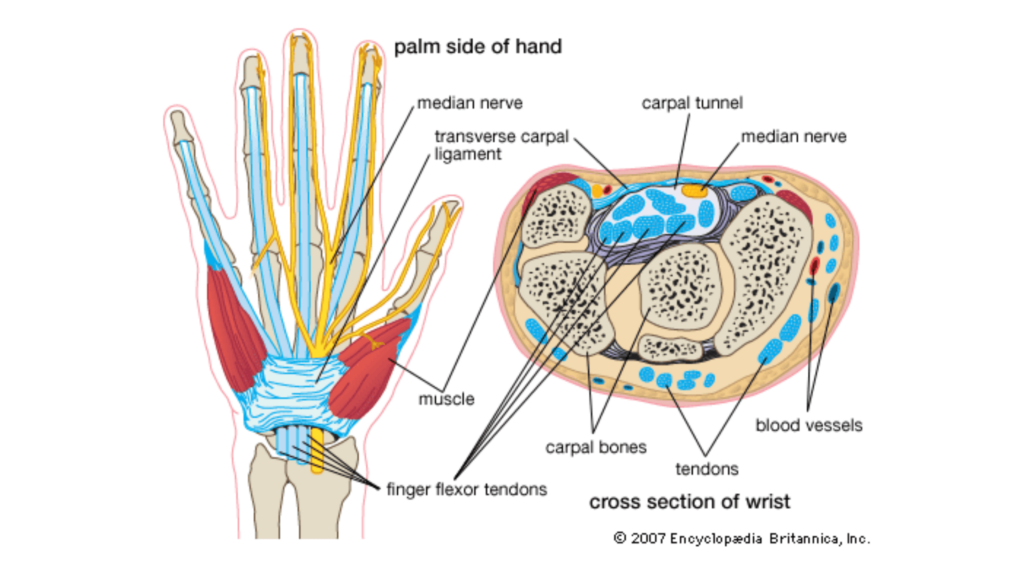Carpal tunnel syndrome is a condition impacting the hands, wrists, and sometimes the forearms that results from compression of the median nerve and is often aggravated by repetitive use of the hands. Hand numbness, tingling, pain, and increased weakness are common symptoms that suggest carpal tunnel, but symptoms may not be constant. Luckily, natural treatments like chiropractic and dietary changes can help prevent the development of carpal tunnel or help to reduce symptoms.
Quick look
- The most common cause of carpal tunnel is overuse of the hand and wrist, but other causes include cysts, osteoarthritis, trauma, or, in some cases, a small tumor.
- Common symptoms of carpal tunnel include tingling, weakness, numbness, and pain in the hand, wrist, and forearm, especially at night.
- Regular gripping of vibratory tools, repeated pinching, wrist-twisting, and unnatural lifts and holds can increase the risk of developing carpal tunnel syndrome.
- Antiinflammatory drugs, chiropractic care, exercise, dietary changes, and certain supplements can improve symptoms of carpal tunnel.
What is carpal tunnel syndrome?

Carpal tunnel syndrome is a medical condition that causes numbness, pain, and tingling in the hand and forearm. The carpal tunnel itself is the space made by the natural arch of your wrist bones. The transverse carpal ligament is a thick, fibrous structure that creates the tunnel’s roof, limiting its ability to change size or shape—the ligament and your bones act as immovable walls. Carpal tunnel syndrome occurs when there’s increased tunnel pressure, and the median nerve becomes compressed.
Carpal tunnel worsens over time in most patients and, if left untreated, can lead to significant or even permanent hand dysfunction, like loss of sensation in the fingers and weakness in the wrist and hand.
The risk of developing carpal tunnel syndrome increases for people in careers that frequently involve their hands. A 2002 study on the prevalence of carpal tunnel syndrome in apprentice construction workers found that 8.2% of general construction apprentices and 9.2% of sheet metal workers experienced carpal tunnel, suggesting a high prevalence in the industry.
Since carpal tunnel tends to become worse over time, it’s essential to identify and treat it as early as possible.
What causes carpel tunnel?
Carpal tunnel can develop for several reasons, but there are generally two routes or mechanisms it takes:
- A decrease in the carpal tunnel size: Mechanical wrist and hand overuse is the most common cause, but osteoarthritis, trauma, and acromegaly (an excess of growth hormone) can also reduce the size of the carpal tunnel and lead to nerve compression.
- A disease state that causes pressure in your carpal tunnel: Cysts, tumors, amyloids, or synovial hypertrophy from rheumatoid arthritis can all increase pressure on the carpal tunnel and cause the nerve to become trapped.
Carpal tunnel syndrome and skilled trades workers

Most jobs in the skilled trades require frequent use of hands and repetitive motions. As such, skilled trades workers, in particular, must pay extra attention to hand motions and repetitive actions on the job that could cause carpal tunnel. Everyday actions tradespeople do that could contribute include:
- Gripping vibratory tools
- Repetitive wrist movements like hammering
- Repetitive wrist twisting like manual screw driving
- Repeated pinching, like holding a tool trigger
- Any awkward repeated wrist movements, holds, or lifts
Common symptoms of carpal tunnel syndrome
In most cases, carpal tunnel symptoms come on gradually and are often hard to notice in the early stages. Here are some early warning signs to look out for:
- Occasional shooting or shock-like sensations that run from your thumb, index, middle, or ring fingers.
- Pain, burning, tingling, or numbness noticeable during the day or wakes you at night; pay particular attention to these sensations if they occur in your thumb, index, middle, and ring finger.
- Clumsiness or weakness in your hands.
- Dropping things due to weakness or unawareness of where your hands are in space.
- Pains or tingling sensations that radiate up your arm toward your shoulder.
Patients find that their symptoms may come and go at first. These could be the early signs of carpal tunnel syndrome and may worsen over time. It’s also common that patients find their symptoms come on stronger during the evening and at night.
Dealing with carpal tunnel in construction
Although it often worsens over time, being diagnosed with carpal tunnel doesn’t mean your career in the trades is over—it typically worsens only when left untreated. Here are some of the most popular options for reducing carpal tunnel symptoms and preventing it from occurring in the first place.
Medical treatments
Depending on the cause of your carpal tunnel syndrome, your doctor may recommend a medical treatment. Prescription drug treatments could include Neurontin, Gabapentin, or Pyridoxine Hcl. They may also choose to inject the carpal tunnel with a corticosteroid medicine such as cortisone for direct pain relief and to reduce swelling. In severe cases, surgery may be recommended.
Alternative treatments

Alternative and holistic treatments have also shown promise for treating and preventing carpal tunnel syndrome.
1. Chiropractic
Chiropractors focus on treating your spine, muscles, nervous system, and the bones, muscles, soft tissues, and joints you use daily. During a chiropractic appointment, a chiropractor will work on realigning and readjusting the wrist bones to adjust the carpal tunnel and reduce pressure on it and the median nerve. Some chiropractors have also tried dry needling, which can offer pain relief for some patients with carpal tunnel.
2. Exercise
Because repetitive movements often trigger carpal tunnel, patients can also exercise to strengthen the area and reduce tunnel suppression. Specific hand and wrist exercises, usually called “nerve gliding exercises,” can help improve your range of motion and let the pressure off the median nerve.
Some of the best exercises for carpal tunnel include:
- Wrist rotations: Rotating the wrists side to side and up and down
- Thumb and finger stretch: Stretching the fingers apart and gently pulling their thumb back
- Wrist stretch: Gently extending their wrist back and forth with their other hand
It’s important, however, not to overstretch to the point of pain or discomfort and cause more swelling and inflammation.
3. Diet
The foods you consume can either help or hinder symptoms of carpal tunnel. Foods that tend to cause inflammation—sugar, unhealthy fats, refined carbohydrates, alcohol, etc.—can trigger inflammation in the body’s tissues, ligaments, and joints. As such, following an anti-inflammatory diet can help reduce inflammatory markers and relieve pain and discomfort. Some of the best anti-inflammatory foods include:
- Omega-3-rich foods like cold-water fatty fish (salmon, sardines, herring, anchovies), flax, and chia seeds. These foods provide the body with healthy, lubricating oils.
- Colorful plant foods contain abundant nutrients, including magnesium and potassium, and can flush excess fluid from the carpal tunnel and reduce swelling.
- Dark leafy greens contain antioxidants that help reduce free radical damage and inflammation and support the healing of injured tissue.
4. Supplements
Natural supplements are another alternative that can provide relief from carpal tunnel symptoms. Here are some to consider:
- Ginko biloba: This natural herb improves circulation and reduces carpal tunnel pressure. It also helps with energy levels.
- Bromelain: The enzyme found in pineapple cores has a natural inflammatory effect. It’s most effective when taken with supplements such as ginger and turmeric.
- Magnesium complex: Magnesium is an electrolyte that helps relax your blood vessels and reduce muscle tension. The more relaxed muscle tissue reduces the compression of nerves in the carpal tunnel.
- B vitamins: Vitamins B6 and B12 support the regeneration and healing of nerve tissue and help with nerve inflammation.
Bottom line
Carpal tunnel syndrome is prevalent in people in careers that constantly use their hands, such as in skilled trades. Pay attention to symptoms like tingling, weakness, and pain in your hand and wrist, even if symptoms aren’t persistent. If you are diagnosed, talk to your doctor about medical treatments or explore alternative remedies like exercises, diet changes, and supplements.
Work on the job site is physically demanding and straining. But if you’re mindful of your repetitive movements and think about carpal tunnel prevention, you’re better set up for the future.
Like this and want more? Subscribe to our weekly newsletter for more on health and wellness for people in the AEC space.


